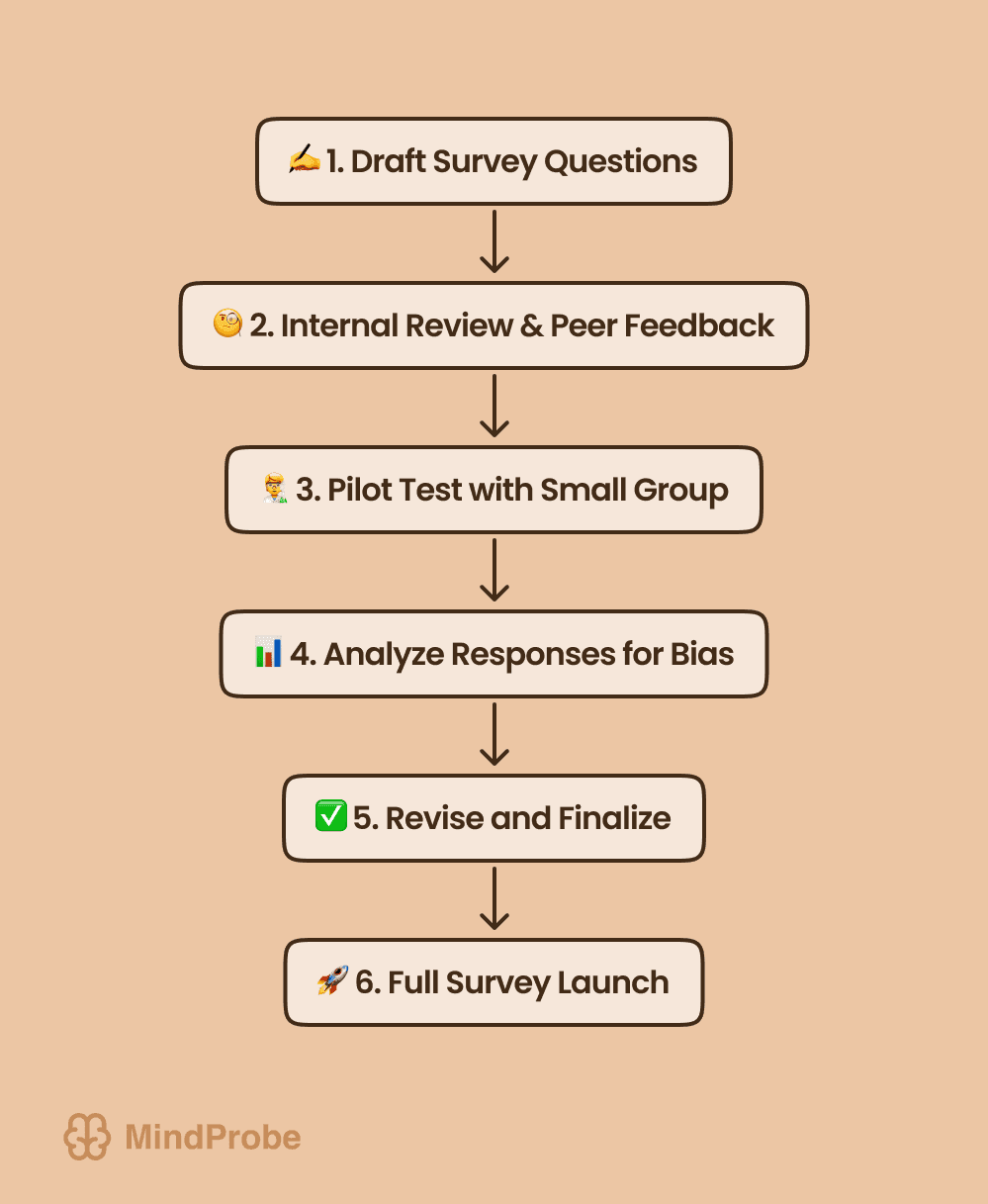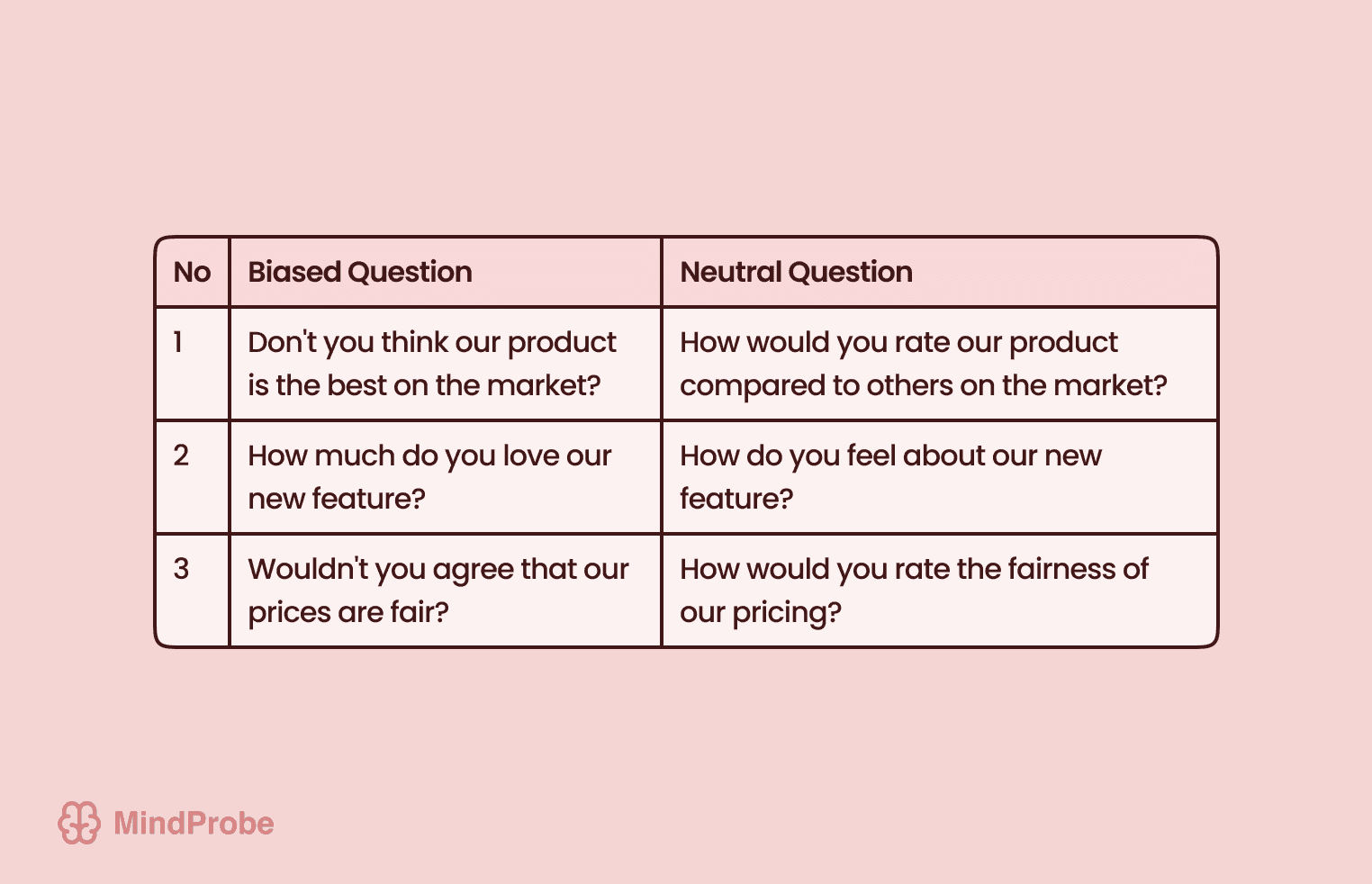How to Avoid a Biased Survey: Crafting Neutral and Objective Questions
Samee

How to Avoid a Biased Survey: Crafting Neutral and Objective Questions
1. Introduction
In the world ofmarket research,customer satisfactionstudies, and B2C marketing, surveys are vital for collecting data-driven insights that inform strategic decisions. However, not all survey data is created equal. When a questionnaire is biased, its results can mislead, misrepresent, or misdirect your organization’s next steps resulting in lost time, wasted resources, and flawed policy or product decisions.
Biased survey can take many forms: they might rely on leading questions, target the wrong audience, or inadvertently pressure respondents into giving a certain type of answer. The good news is, by focusing on crafting neutral and objective questions, you can dramatically reduce bias and create data that truly reflects the voice of your customer.
In this comprehensive guide, we’ll explore why biased surveys undermine your results, break down the different types of bias that often lurk in questionnaires, and offer practical tips on how to design surveys that yield credible, actionable insights. Along the way, we’ll also show how we at MindProbe (an AI-powered market research service) offeringsentiment analysisand auto-tagging can help you catch and correct potential biases before they compromise your data.
2. Understanding Survey Bias
At its core, survey bias refers to any element be it in the question wording, sample selection, or answer options that systematically skews the responses. For example, a survey that leads respondents to a particular conclusion or excludes certain groups might not reflect the broader population’s sentiments. These distortions can drastically impact how accurately your final data reflects reality.
Survey bias is not always intentional. In many cases, it stems from unconscious assumptions or inadequate attention to design details. What might seem like a harmless question “Would you agree that our product is highly innovative?” can subtly steer respondents toward a positive response. Understanding these hidden pitfalls is the first step to creating surveys that are neutral, fair, and more likely to yield valid insights.
3. Why Biased Surveys Undermine Your Results
Biased surveys are more than a methodological inconvenience they can lead to faulty decisions and missed opportunities:
1. Misguided Product Strategy
- If your survey disproportionately collects data from a niche segment, you could invest in features that satisfy a small group while neglecting the broader customer base.
2. Inaccurate Market Positioning
- Leading questions may paint an unrealistically rosy picture of brand perception, causing you to miss genuine areas for improvement or risk.
3. Loss of Trust
- If respondents sense they are being nudged toward certain answers, they may lose confidence in your brand’s authenticity or regard your research efforts as manipulative.
4. Wasted Resources
- Time, money, and manpower spent on designing, distributing, and analyzing a biased survey can be effectively thrown away, as the resulting data may not be actionable or reliable.
In short, avoiding bias is essential if you want your surveys to drive real impact and enhance, rather than distort, your organization’s decision-making processes.
4. Different Types of Survey Bias
4.1 Leading Question Bias
Occurs when the wording of the question suggests a preferred or “correct” answer. Phrases like “Don’t you agree that…?” or “How amazing is our new product?” tilt respondents toward positive responses.
4.2 Sampling Bias
If you’re only surveying a subset of your audience for instance, targeting existing brand advocates your findings may not reflect the broader market or those dissatisfied customers who never return.
4.3 Response Bias
Respondents might give answers they believe are more acceptable or aligned with the perceived survey sponsor’s viewpoint. Alternatively, they might “straight-line” responses, giving the same rating throughout if the survey is too long or complex.
4.4 Social Desirability Bias
People often portray themselves in a favorable light, even in anonymous surveys downplaying opinions they fear might be judged. This can be a major issue in sensitive topics like sustainability, politics, or health.
4.5 Non-Response Bias
When a particular group is less likely to respond to a survey perhaps due to language barriers, disinterest, or lacking internet access the final sample might skew away from their viewpoints, limiting generalizability.
5. Elements of Neutral Survey Question Design
5.1 Clarity and Simplicity
Unclear questions can force respondents into guessing their meaning. Use straightforward language with minimal jargon to reduce confusion and potential misinterpretation.
5.2 Avoiding Emotional or Loaded Language
Words like “fantastic,” “appalling,” or “unfortunately” carry inherent emotional weight. Keep your tone objective and let respondents supply their own emotional context.
5.3 Balanced Answer Choices
Offer symmetrical scales (e.g., from “strongly disagree” to “strongly agree”) or a neutral midpoint so that all respondents positive, negative, or indifferent can find a suitable response.
5.4 Strategic Placement and Context
Order matters. Put sensitive or complicated questions later, once participants are more engaged, and begin with simpler queries to build trust and context.
5.5 Pilot Testing and Feedback
Consider running a small-scale pilot with colleagues or a subset of your audience to spot confusing language, biased structures, or misaligned scales before rolling out the final survey.
6. Practical Tips for Crafting Objective Questions
6.1 Use Neutral Wording
- Biased: “Don’t you agree our packaging is convenient and eco-friendly?”
- Neutral: “How would you rate the convenience and environmental impact of our packaging?”
Shifting from a yes/no structure to a rating or open-ended question can help remove implicit guidance toward a specific viewpoint.
6.2 Offer Opt-Out Options
Sometimes respondents truly have no opinion. Provide “Not Applicable” or “Prefer Not to Answer” choices for select questions to avoid forcing them into a response that doesn’t reflect their true views.
6.3 Apply Consistent Scales
Switching from a 1–5 rating scale for one question to a 1–7 scale for another can confuse participants. Consistency fosters clarity and helps you compare results across different sections.
6.4 Employ Branching Logic Wisely
If a user indicates they haven’t used your premium features, there’s no need to show them in-depth questions about that feature set. Proper skip logic ensures respondents only see relevant items, reducing guesswork and respondent fatigue.
7. Leveraging MindProbe to Detect and Reduce Bias
7.1 AI-Powered Sentiment Analysis & Auto-Tagging
MindProbe goes beyond standard survey platforms by incorporating artificial intelligence that quickly flags potential biases or anomalies in responses. The tool can detect if your open-ended questions consistently generate extremely positive or negative feedback, suggesting potential leading phrasing. By auto-tagging themes, MindProbe helps you identify whether the data skews toward a certain viewpoint and whether your question design might be partially responsible.
7.2 Real-Time Feedback Monitoring
When you distribute a survey via MindProbe, you can monitor live dashboards as responses come in. If you see a cluster of respondents dropping out after a specific question possibly because it’s too personal or perceived as leading you can revise or remove it in real time before collecting hundreds or thousands of compromised responses.
7.3 Free Subscription Tier
At MindProbe we offer a free account with almost full functionality, enabling you to test advanced features like sentiment analysis and auto-tagging to detect bias early on. This approach ensures you’re fully equipped to evaluate how MindProbe’s advanced analytics can keep your surveys objective and your data credible.

8. Real-World Examples of Biased vs. Neutral Questions
8.1 Customer Satisfaction
- Biased: “Don’t you think our customer service team is incredibly helpful?”
- Neutral: “How would you rate your experience with our customer service team?”
- Rationale: The first question uses the word “incredibly,” pushing for a positive response.
8.2 Product Feature Validation
- Biased: “What did you love most about our new feature?”
- Neutral: “How would you describe your experience with our new feature?”
- Rationale: The term “love” presupposes a positive reaction. Replacing it with “describe your experience” is more balanced.
8.3 Pricing Surveys
- Biased: “Do you believe our affordable subscription rate offers excellent value?”
- Neutral: “How would you rate the value of our subscription rate compared to the market?”
- Rationale: Labeling the rate as “affordable” sets a preconception. The second example simply asks for comparative feedback without an agenda.

9. Overcoming Common Challenges in Eliminating Bias
9.1 Time Constraints and Rushed Question Design
When a survey must be launched under tight deadlines, the risk of slipping into leading language or vague queries soars.
- Solution: Use templates and best-practice question banks (like those provided by MindProbe). If time allows, run a pilot or gather peer feedback to spot potential biases quickly.
9.2 Internal Stakeholder Agendas
Marketing or product teams may push for phrasing that highlights brand successes or new features, inadvertently inserting bias.
- Solution: Keep survey design under a cross-functional review. Involve a neutral third party like an external researcher or a different department for final sign-off.
9.3 Language Barriers and Localization Issues
Translating a survey for international audiences can shift nuance or add loaded connotations.
- Solution: Collaborate with local experts or professional translators to ensure neutral phrasing across languages. Re-run pilot tests in each local market.
9.4 Large-Scale Surveys with Multiple Contributors
In bigger organizations, multiple teams might add questions to a single survey. Without central oversight, inconsistency and bias can creep in.
- Solution: Establish a design lead or small committee to coordinate final question approvals, ensuring uniform style and neutrality.
10. Integrating Checks and Balances Into Your Survey Process
10.1 Peer Review and Collaboration
Once you draft a survey, share it with colleagues for feedback. They might spot loaded words, vague references, or questionable scales.
10.2 Soft Launch or Pilot Runs
Distributing the questionnaire to a smaller group before a full release helps identify friction points and biases. Use open-ended feedback to refine your approach.
10.3 Ongoing Data Analysis for Anomalies
As responses roll in, watch for unexpected patterns: extremely skewed results or high dropout rates at certain questions. These red flags may indicate bias, confusion, or irrelevance.
11. Future Trends in Survey Bias Detection and Prevention
Survey methodologies evolve as technology and consumer behavior change. Expect to see:
1. AI-Driven Question Validation: Tools (like MindProbe’s advanced features) that automatically flag potential bias in question wording, sample selection, and answer sets.
2. Multilingual Sentiment and Bias Analysis: As brands go global, fully integrated language-support models can detect region-specific or cultural nuances that might cause unintentional leading questions.
3. Voice-Based Surveys: The rise of voice assistants could shift how questions are asked and answered, requiring new best practices for avoiding bias through tone or phrasing.
4. Adaptive Surveys: Real-time data analytics can dynamically tailor subsequent questions to each respondent, ensuring balanced coverage and minimizing extraneous or irrelevant prompts.
By staying up to date on these trends, organizations can future-proof their survey strategies and maintain high data quality.
12. Conclusion
Crafting neutral and objective survey questions is both an art and a science. On one hand, it demands a methodical approach to wording, sampling, and question structure; on the other, it requires a keen awareness of subtle psychological cues and an attentiveness to the respondent’s experience. When done right, the results are transformative: robust data that genuinely reflects the attitudes, needs, and preferences of your B2C audience.
Avoiding leading questions, balancing answer choices, and systematically reviewing for hidden biases can pay off immensely preventing misguided product decisions, marketing missteps, or wasted resources. Tools like MindProbe further simplify the process by leveraging AI-powered sentiment analysis and auto-tagging to highlight anomalies, monitor real-time responses, and keep your survey on the right track.
Remember, a well-crafted, bias-free survey doesn’t just yield reliable insights it also fosters trust among respondents, reinforcing your brand’s credibility. As you refine your approach to question design, you’ll set the stage for data-driven decisions that propel your organization towards greater customer satisfaction, loyalty, and market success.